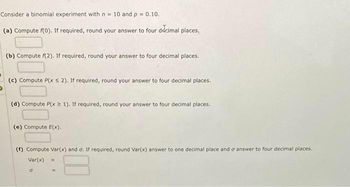
Advanced Engineering Mathematics
10th Edition
ISBN: 9780470458365
Author: Erwin Kreyszig
Publisher: Wiley, John & Sons, Incorporated
expand_more
expand_more
format_list_bulleted
Question

Transcribed Image Text:Consider a binomial experiment with n = 10 and p = 0.10.
(a) Compute f(0). If required, round your answer to four decimal places.
(b) Compute f(2). If required, round your answer to four decimal places.
(c) Compute P(x ≤ 2). If required, round your answer to four decimal places.
(d) Compute P(x 1). If required, round your answer to four decimal places.
(e) Compute E(x).
(f) Compute Var(x) and σ. If required, round Var(x) answer to one decimal place and a answer to four decimal places.
Var(x)
0
Expert Solution
This question has been solved!
Explore an expertly crafted, step-by-step solution for a thorough understanding of key concepts.
Step by stepSolved in 6 steps

Knowledge Booster
Similar questions
- In a certain state the proportion of families living below the poverty level is 21 %. For samples of n = 750 randomly selected families, what is the probability that the sample proportion of families that live below the poverty level is within ±0.03 from the population proportion? z= (p-π)/√(π(1-π)/n) I got an answer of 0.9566. I am not sure if it's right. Can the problem be worked out so I can better understand it?arrow_forwardConsider a binomial experiment with n = 14 and p = 0.5. a. Compute f(0) (to 4 decimals). f(0) = b. Compute f(3) (to 4 decimals). f(3) = %3D c. Compute P(r 4) = e. Compute E(x) (to 1 decimal). E(r) = f. Compute Var(z) and o. Var(x) = (to 2 decimals) (to 2 decimals)arrow_forwardConsider a binomial experiment with n = 14 and p = 0.3. a. Compute f(0) (to 4 decimals). f(0) = b. Compute f(5) (to 4 decimals). f(5) = c. Compute P(x 2) (to 4 decimals). P(x > 2) = e. Compute E(x) (to 1 decimal). E(x) = f. Compute Var(x) and o. Var(x) = (to 2 decimals) O = (to 2 decimals)arrow_forward
- If S = {a,b,c} with P(a) = P(b) and P(c) = 0.24, find P(a). (Enter answer as a decimal with at least 2 correct decimal places)arrow_forwardConsider a binomial experiment with n = 10 and p =0.1. a. Compute f(0) (to 4 decimals). /(0)% = b. Compute f(5) (to 4 decimals). f(5) = c. Compute P(2 4) = e. Compute E(2) (to 1 decimal). E(x) = f. Compute Var(a) and a. Var(x)= (to 2 decimals) (to 2 decimals)arrow_forwardGive the formula for p(x) for a binomial random variable with n= 6 and p = 0.4. -.. - O'O (x=0, 1, 2 ...D p(x) = (Simplify your answers. Use integers or decimals for any numbers in the equation.)arrow_forward
- Suppose that we calculated Rs=.21 (n=15). Do we reject or accept the null hypothesis at p<.01arrow_forward(c) Suppose n = 65 and p = 0.40. (For each answer, enter a number. Use 2 decimal places.)n·p = n·q = fourth blank (Enter an exact number.)What are the values of μp̂ and σp̂? (For each answer, enter a number. Use 3 decimal places.)μp̂ = mu sub p hat = σp̂ = sigma sub p hat =arrow_forwardPlease solve using Rarrow_forward
arrow_back_ios
arrow_forward_ios
Recommended textbooks for you
 Advanced Engineering MathematicsAdvanced MathISBN:9780470458365Author:Erwin KreyszigPublisher:Wiley, John & Sons, Incorporated
Advanced Engineering MathematicsAdvanced MathISBN:9780470458365Author:Erwin KreyszigPublisher:Wiley, John & Sons, Incorporated Numerical Methods for EngineersAdvanced MathISBN:9780073397924Author:Steven C. Chapra Dr., Raymond P. CanalePublisher:McGraw-Hill Education
Numerical Methods for EngineersAdvanced MathISBN:9780073397924Author:Steven C. Chapra Dr., Raymond P. CanalePublisher:McGraw-Hill Education Introductory Mathematics for Engineering Applicat...Advanced MathISBN:9781118141809Author:Nathan KlingbeilPublisher:WILEY
Introductory Mathematics for Engineering Applicat...Advanced MathISBN:9781118141809Author:Nathan KlingbeilPublisher:WILEY Mathematics For Machine TechnologyAdvanced MathISBN:9781337798310Author:Peterson, John.Publisher:Cengage Learning,
Mathematics For Machine TechnologyAdvanced MathISBN:9781337798310Author:Peterson, John.Publisher:Cengage Learning,


Advanced Engineering Mathematics
Advanced Math
ISBN:9780470458365
Author:Erwin Kreyszig
Publisher:Wiley, John & Sons, Incorporated

Numerical Methods for Engineers
Advanced Math
ISBN:9780073397924
Author:Steven C. Chapra Dr., Raymond P. Canale
Publisher:McGraw-Hill Education

Introductory Mathematics for Engineering Applicat...
Advanced Math
ISBN:9781118141809
Author:Nathan Klingbeil
Publisher:WILEY

Mathematics For Machine Technology
Advanced Math
ISBN:9781337798310
Author:Peterson, John.
Publisher:Cengage Learning,

